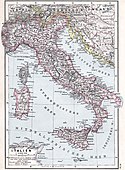User:Foghe/U
 Satellite image of Italy | |
 | |
| Geography | |
| Location | Europe |
| Coordinates | 42°N 12°E / 42°N 12°E |
| Adjacent to | Mediterranean Sea |
| Largest city | Rome |
| Area | 322,470 km2 (124,510 sq mi) |
| Highest elevation | 4,808 m (15,774 ft) |
| Highest point | Mont Blanc |
| Administration | |
| Status | Divided among eight sovereign states |
Whole territory | |
Whole territory | |
Whole territory | |
Whole territory | |
| Demographics | |
| Demonym | Italian |
| Population | c. 60,000,000 |
| Pop. density | 186/km2 (482/sq mi) |
| Languages | Official: Italian, Maltese, German, French, Slovene, Croatian |
| Ethnic groups | 92.0% Italians 0.6% Germans 0.5% Slovenes 0.4% Croats 0.2% French 6.3% Other |
| Additional information | |
| Time zone | |
| Religions | 95.0% Christianity 3.4% Islam 0.1% Judaism 1.5% Other |
Italy (Italian: Italia) is a nation in Europe. Its territory consists of the Italian Peninsula, delimited by the Alps to the north and by the Mediterranean Sea to the south, and of all of the surrounding and related islands, among which are the three largest of Sicily, Sardinia, and Corsica.[1]
The nation is governed separately by eight states, of which only four include an Italian population majority: the Italian Republic, the Republic of San Marino, the Vatican City State, the Republic of Malta, the French Republic, the Swiss Confederation, the Republic of Slovenia, and the Republic of Croatia. Italy has a population of circa 60 million people, of which 55 million are citizens of states ruling part of the territory. With an area of circa 322,000 square kilometers (124,300 sq mi) it has a population density of around 186 inhabitants per square kilometer (480/sq mi). The largest city is Rome, with 2.9 million residents.[2]
Italy has been for millennia the focus of Western civilization and culture. In legal studies, Roman law forms the ground for several juridical orders. Religiously, Christianity has been the main creed since the end of the Classical period—the Catholic Church holds its headquarters in Vatican City, an enclaved independent city-state in Rome. Italians mantain a set of distinctive characters of Italian culture, concerning interest regarding food, fashion, architecture, art, and music, scattered around the world through the Italian diaspora (1860s–1920s).
History[edit]
Classical period[edit]
The current sociological extent of Italy came into existence during the process of expansion of the Roman Republic in the region, spanning six centuries, from the 3rd century BC to the 3rd century AD. Initially, Italy, as originally defined by the Greeks, geographically identified only the southern part of the region, know as Magna Graecia, in which Hellenic civilization flourished starting from the 8th century BC.
With the consolidation of Roman rule over the peninsula (275 BC) and over the surrounding islands (237 BC), as results of the Pyrrhic and Punic Wars, the territory
Abc.
Abc.
Modern period[edit]
Abc.
Abc.
Abc.
Abc.
Abc.
Contemporary period[edit]
Abc.
Abc.
Abc.
Abc.
Abc.
Physical geography[edit]

Il bel paese
ch'Appennin parte e 'l mar circonda et l'Alpe.That fair country
the Apennines divide, and Alps and sea surround.— Petrarch
Continental part[edit]
Abc.
Peninsular part[edit]
Abc.
Insular part[edit]
Abc.
Sicily[edit]
Abc.
Sardinia[edit]
Abc.
Corsica[edit]
Abc.
List of island by area[edit]
Abc.
| Island | Area | Sea | |
|---|---|---|---|
| km2 | sq mi | ||
| Sicily | 25,460 | 9,830 | Mediterranean, Ionian |
| Sardinia | 24,090 | 9,300 | Mediterranean, Tyrrhenian |
| Corsica | 8,681 | 3,352 | Mediterranean, Tyrrhenian |
| Cres | 406 | 157 | Adriatic |
| Malta | 246 | 95 | Mediterranean |
| Elba | 223 | 86 | Tyrrhenian |
| Sant'Antioco | 109 | 42 | Mediterranean |
| Pantelleria | 83 | 32 | Mediterranean |
| Lošinj[a] | 74 | 29 | Adriatic |
| Gozo | 64 | 25 | Mediterranean |
| Asinara | 51 | 20 | Mediterranean |
| San Pietro | 51 | 20 | Mediterranean |
Bodies of water[edit]
Abc.
Political geography[edit]
Dall'Alpi a Sicilia, dovunque è Legnano.
From the Alps to Sicily, Legnano is everywhere.
Abc.
| Italian Republic — Whole territory — |
Republic of San Marino — Whole territory — |
Vatican City State — Whole territory — |
Republic of Malta — Whole territory — | |||
|
View of Rome
|
View of San Marino
|
View of the Vatican
|
View of Valletta
| |||
| French Republic — Corsica — |
Swiss Confederation — Ticino, Grisons — |
Republic of Slovenia — Littoral — |
Republic of Croatia — Istria — | |||
|
View of Ajaccio
|
View of Lugano
|
View of Koper
|
View of Pula
| |||
Demography[edit]

Abc.
Nationality[edit]
Natives[edit]
Abc.
Oriundi[edit]
Abc.
Languages[edit]
Abc.
Religions[edit]
Abc.
Culture[edit]
Pagan period[edit]
Abc.
Christian period[edit]
Abc.
Notes[edit]
Footnotes[edit]
- ^ L'appartenenza o meno delle isole di Cherso, Lussino e Veglia alla regione geografica italiana varia a seconda delle fonti. In particolare taluni vedono le prime due come continuazione naturale della penisola istriana, essendo tra l'altro Cherso e Lussino più vicine alla costa istriana che a quella dalmata, a differenza di Veglia. Inoltre varie isole minori mostrano una continuità tra Veglia e Arbe, isola nettamente dalmata.[translation needed]
References[edit]
- ^ De Agostini Ed., L'Enciclopedia Geografica. Vol.I: Italia, 2004, p. 78.
- ^ La Popolazione di Roma. Comune di Roma (in Italian). Published June 2018. Retrieved 8 October 2021.
External links[edit]
- Abc.












